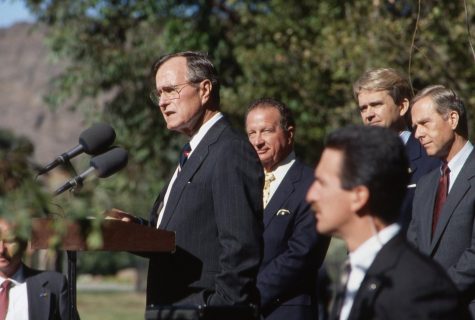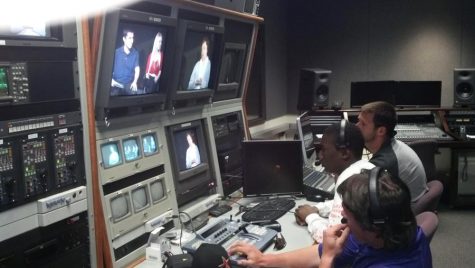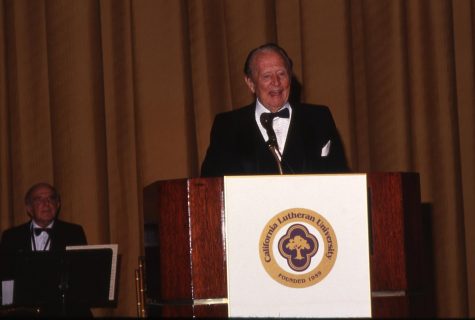1990
November 25, 2020
This section mentions rape, suicide and racism.
May 3: Former First Lady Nancy Reagan receives the Landry Medal.
“We had a fundraising banquet that was down in Beverly Hills, I think it was at the Beverly [Wilshire], it was very lovely,” Jean Sandlin Associate Dean, Interdisciplinary Studies & Community Outreach, Professor and alumna B.A. ‘84, M.A. ‘90, P.h.D. ‘12 said in an interview on Nov. 10, 2020. “Ronald Reagan and Nancy Reagan were kind of the guest speakers. And I remember because I was super pregnant and I had to go down there as Media Relations [for the university] and I had to wear a–I’m not sure if they would have [the pictures]–fancy dress. A dress I will never wear again and I just remember I was so big I could barely fit behind my steering wheel to get myself down to Beverly Hills I was so pregnant, but anyway yeah and doing all of the media work for the Reagan’s and they did like pictures with some of the donors that wanted pictures.”
Nov. 3: President George H.W. Bush visits campus.

Despite pushback from the student body, “President George H. W. Bush appeared on campus on November 3, 1990, at a rally to support Republican Senator Pete Wilson’s bid for governor of California,” according to “College of Our Dreams.”
According to the book, nearly 1,000 students and visitors gathered to listen to him speak over loudspeakers across campus. “After the address, the President led the audience to the east side of Kingsmen Park to plant an oak tree. Looking out over the campus and citing the name of the city, he asked for a ‘thousand points of shade,’ or, more correctly, he quipped ‘It’s going to be 1,001.’ When the original tree died, it was replaced by another one at the other end of the park and marked with a plaque commemorating the president’s visit.”
Kuehnel said one of the primary things she remembers about political appearances at Cal Lutheran is how staged they were. “It was pretty staged to look like it was a lot of people all rah rah and everything.”
Sandlin, who was Cal Lutheran’s public information officer at the time, said she remembers taking extra steps to protect the president from any potential threats.
“I had to first of all get security clearance. And once I had security clearance, I worked with the secret service team to set up where the president was going to be and where they could hold him and all this kind of stuff and I remember working really hard to get a classroom. for this particular day and then I was really upset because they didn’t end up using it,” Sandlin, said. “Because they do all of these decoy things. it was kind of interesting to get to know how you protect the president kind of thing.”
1991
Cal Lutheran hires its first Black professor.
“What I knew about Cal Lutheran was very impressionistic, and I’m a runner so the first thing you probably brought me to campus was probably your 5K,” Russell Stockard, professor of Communication, said in a Zoom interview on Oct. 19, 2020. “So when I first came on campus, it was still Cal Lutheran College, and you know it seemed like–oh this nice is picturesque and glad it’s here. You know, when you’re an academic you always want to be close to a campus.”
May 9: The President of Nicaragua, Violeta Barrios de Chamorro, is presented with the Landry Medal at a black–tie dinner at the Regent Beverly Wilshire, Los Angeles.
The event was attended by stars such as Charlton Heston and Chuck Norris.
The link to this article will only be available for those with access to Pearson Library.

1992
Hiring practices start becoming more equitable.
Prior to the early 90s, “the staff was been made up of like friends of friends from local Lutheran churches,” Gregory Freeland, professor of Political Science, said in a Zoom interview on Oct. 14, 2020.
Freeland, Cal Lutheran’s second Black professor, was hired in 1992.
“Everybody belonged to two or three Lutheran churches here in Thousand Oaks, right, they all belong to each other. And the faculty was pretty much all male. You know, there are a few females around like Julie Kuehnel was around because she actually graduated from here… and the other one… was Michaela Reaves, she also graduated from here,” Freeland said. “In the early days, it was almost like, you know, it was like a real inside community.”
Despite this shift, “Russell Stockard and I have been the only two Black male professors on campus for two decades,” Freeland said.
May 1: Students lead speeches in Kingsmen Park after the Rodney G. King verdict.
Oct. 22: Cal Lutheran holds a play on racism.
Russell Stockard and I have been the only two Black male professors on campus for two decades.
— Gregory Freeland, Professor of Political Science
1994
Aug. 8: A local poet produces a magazine discussing racism in Simi Valley and a Cal Lutheran professor says it is necessary.
The link to this article will only be available for those with access to Pearson Library.
1995
March: Cal Lutheran presents the Landry Medal to an ARCO oil executive.
July 8: Los Angeles ‘White Aryan Resistance’ stuffs Thousand Oaks mailboxes with racist flyers.
“I believe it could’ve been some supremacist group out there in, you know, out in this area, you know, Simi Valley and so on,” Freeland said.
Oct 3: OJ Simpson is acquitted and Cal Lutheran faculty gathers in media services to watch the verdict.
“I’ll never forget the OJ trial,” David Grannis, professor of Communication, said in a Zoom interview on Nov. 11, 2020. “When like 20 faculty suddenly burst into my door so that they could watch the verdict. And there was this massive, massive screaming of protest when they found him innocent. And I remember one professor from England saying that would never happen in her country.”
1996

(Photo courtesy of David Grannis)
Grannis tries to spark interest in starting the Film and TV major.
“You know, it’s funny. Back then, I remember hearing one of the comm[unication] advisers telling one of my students saying, don’t go into film/TV, there’s no future there–journalism is where it’s at, you know, all the jobs are in newspapers. And then you know in the next five years are 50% of the newspapers in America collapse and digital journalism became the thing,” Grannis said.
March: Art Linkletter, a CBS and NBC radio personality, receives Cal Lutheran’s Landry Medal.

The Los Angeles Times reported, “recalling the death of one of his own daughters to drugs, this year’s [Landry Medal] winner, Art Linkletter, 83, said it was a turning point for him in his own work with the young. ‘That terrible tragedy changed my whole life,’ said Linkletter, who has been a strong anti-drug crusader ever since. ‘I began doing all the things that didn’t pay money, but paid in satisfaction.’”
Oct. 31: Jack Kemp, Republican vice presidential candidate, attends Cal Lutheran rally.
“That was the first time I ever saw a big protest at Cal Lutheran,” Grannis said. “He was the Republican nominee [for Vice President]. And at that same time, you know Affirmative Action–it just lost [in 2020] right–but many years ago, you’d have to do some research on it. I thought it was prop 187, and it was up for a vote and that’s the first time it lost, this year is the second time it lost. But there was big protests about that.”
It was odd to have a Republican candidate campaign on campus, Sharon Docter, professor of communication, said in a Zoom interview on Nov. 11, 2020.
“[Kemp came to campus] around the time that… prop 187, which was a proposition that basically said, California should not fund undocumented immigrants for… health care, education, we should not be spending public funds on people who are not documented,” Stockard said. “These people from Thousand Oaks in, you know, sort of the surrounding community, when they’d see Latino or Latina… Latinx students, they would go–in some cases, insane–and start you know telling [the students] to go back to wherever they came from.”
1997
April 10: Thousand Oaks Police investigate racist graffiti on campus as a hate crime.
The link to this article will only be available for those with access to Pearson Library.
“There was a student who was going around with a big, giant felt pen, a big marker, writing the N word. He wrote it on the wall[s] and [was] putting racist literature, I don’t know what kind… under the windshield wipers of Black Cal Lutheran students,” Grannis said. “We had security cameras and went through the footage and found a picture of a guy in a trench coat. And this was after Basketball Diaries came out… that was a movie that inspired the Columbine shooting… in the movie… these guys come in in trench coats and shoot everybody in the class… and this kid had the trench coat. It was a black pen, a black sleeve… we took a freeze frame of that one image, and the officers took them into the chapel, and they showed him the picture and he started crying… he admitted to the whole thing. And that was that, man you know his life was ruined.”
Docter said she also has a strong recollection of the events.
“I think there was concern and shock because it was so overtly racist and so hateful. My recollection is, you know, things like neo-Nazi symbols and racial epithets and such,” she said. “[The] footage was distributed to all of the residents, the RAs to tried to identify who the person was and to try and figure out if it was somebody from the campus community. Once that happened, I actually knew the RAs that identified the person… The university, my recollection is that, they acted pretty swiftly and expelling him and criminal charges were brought against him as well.”
April 15: Student Kevin Tam is arrested, cited for misdemeanor vandalism and expelled.
The link to this article will only be available for those with access to Pearson Library.
Students sign a poster, committing themselves to prevent racism on campus after a Joe Hicks seminar.
“In terms of the campus community, I think there was, you know, widespread kind of dismay and concern, it led to lots of conversations about hate speech about racism in our classrooms,” Docter said. “There was a forum held and Joe Hicks, who was a famous civil rights leader, came and spoke to the campus community at the time to talk about issues of, you know, systemic racism and, yeah, led to a lot of conversation and dialogue.”
April 16: Los Angeles Times reports on Cal Lutheran’s seminar on racism, led by Joe Hicks.
April 17: The second student involved in the racist graffiti is arrested.
Nov 16: Some Ventura County community members acknowledge the pervasiveness of racism throughout the community.
The link to this article will only be available for those with access to Pearson Library.
Dec 17: Cal Lutheran is praised for its ‘Latino programs.’
The link to this article will only be available for those with access to Pearson Library.
1999
April 26: A student overdoses on alcohol and dies in their dorm room.
Nov 15: A student is accused of multiple counts of rape.
Nov 30: The student accused of rape pleads not guilty.
The link to this article will only be available for those with access to Pearson Library.